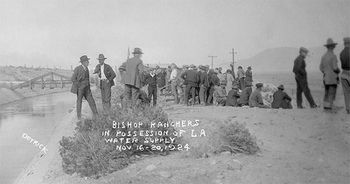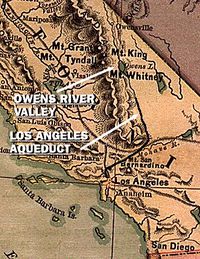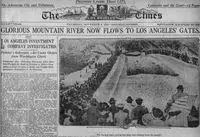What Were the LA Water Wars
The Los Angeles Water Wars represent a significant moment in Los Angeles history. As Los Angeles swelled in the first few decades of the 20th century, it quickly used up much of its available water resources. Historians of the American west have extensively noted that water was often the key to determining the success or failure of a settlement. In the arid landscape of the American West, water was a sacred commodity. Water was critical to the indigenous communities that originated there and became essential to accommodate the immigrants who eventually made their way west.[1]
California's unusual water laws
Since the Gold Rush, Californians were quick to shift their understanding of property rights to best represent their interests in the mineral wealth their land could produce. While this originally occurred with gold, it was quick to occur with water as well. According to Remi Nadeau, in the American west, "these epic contests were fought in the realm of water law. Throughout most of the Far West, this body of law was based on the miner’s code of 'first in use, first in right'–even though the benefited land was not contiguous to the water source. But in California, water law flowed from two origins--the priority rights established by the early American miners, and the riparian rights for contiguous land, according to the Spanish tradition and the English common law."[2]
Water rights in English common law emphasized riparian rights, meaning that anyone who bordered a stream had a right to its flow of water. Nevertheless, late 19th-century irrigation projects in California removed water from the stream and violated the Riparian rights of those downstream of the irrigator. By 1887, California’s legislature approved a law that permitted residents in a particular area to form an irrigation district with legal authority to take water for irrigation regardless of downstream claims. Thus allowing California to lead the nation in the amount of irrigated farmland.
Water Wars
The Los Angeles Water Wars, immortalized by Roman Polanski's Chinatown, emerged against this backdrop. Fighting for water justified legal cunning and violence for many Angelenos in the late 19th and early 20th century. When a long drought from 1892-1904 threatened to damper Los Angeles' growth and survival, city officials recognized the need to find a new source of water quickly. The Mayor of Los Angeles, through bribery and trickery, facilitated the construction of the Los Angeles Aqueduct to feed the water needs of Los Angeles--much to the detriment of those where the water came from--the Owens Valley.
The Players in the LA Water Wars
This post serves as an introduction to the cast of characters who played a pivotal role in the construction of the Los Angeles Aqueduct, and with the Water Wars. It does not address many of the intricate details of the water wars, nor of the San Fernando syndicate. Those details will follow in a future post.
Frederick (Fred) Eaton: Eaton was born in the area to a prominent family. Eaton was a self-taught engineer, and eventually became superintendent of the Los Angeles City Water Company. It was at this job where he met William Mulholland. In 1898, Eaton was elected Mayor of Los Angeles. Under his leadership, he created the Los Angeles Department of Water and Power in 1902. Eaton, together with Mulholland, would be the driving force behind the construction of the Los Angeles Aqueduct. Eaton was able to purchase enough land in the Owens Valley and to bribe enough officials to do this.
William Mulholland: Mulholland was an Irish immigrant who came to the United States in the 1870s. Mulholland began his career in the water business as a ditch-digger.[3] Over time, he taught himself engineering. It was here where he met Eaton, and once Eaton became mayor and created the Los Angeles Department of Water and Power, Mulholland assumed his position at its head. He would remain there in that position until 1928.
Joseph Lippincott: Lippincott was born in Scanton, Pennsylvania in 1864. He attended college in Carlisle, Pennsylvania and in Lawrence, Kansas. He became an engineer for the Santa Fe Railway system before eventually working for the United States Geological Survey. He worked as an engineer for a number of other irrigation projects in Southern California before becoming the resident hydrographer for the State of California's branch of the USGS. Eventually, Lippincott became the supervising engineer of all water reclamation projects on the Pacific Coast. He would eventually be hired by onto a board of engineers to assist with the Los Angeles water projects in 1905. Through his position, we was able to effectively argue for Los Angeles' need to tap into outside water sources, like the Owens Valley.[4]
United States Reclamation Service: The USRS was founded in 1902 as a division within the USGS. It was a federal agency, and its primary purpose was to oversee water resource management through a number of different projects. At the turn of the 20th century, the USRS was planning an irrigation project for the potentially high-yield agricultural area. The project would have irrigated approximately 185,000 acres of land in the vicinity. Once it was clear that Eaton had purchased enough land and had created enough hurdles, the USRS was unable to proceed with its Reclamation project--opening the doors for Eaton's plan to take the Owens Valley's water.
Owens Valley Residents & Farmers: The Owens Valley was situated about 200 miles north of Los Angeles. The area was quite fertile thanks in part to the Owens River and the runoff from the Sierra Nevada mountains. Most of the people who lived in the Owens Valley "raised crops and ranched, and they were anticipating an economic bonanza" once the USRS Owens Valley project was completed.[5] Once the aqueduct was constructed, it diverted water away from the residents and farmers of the Owens Valley, and effectively washed away their dreams. They fought back in many ways--even dynamiting part of the aqueduct and occupying and draining another.
History of Los Angeles
The city of Los Angeles was founded by a small group of Spanish settlers on September 4, 1781. During much of the Spanish colonial period, Los Angeles remained an outpost, a relatively small pueblo far away from the colonial hub and center in present-day Mexico. As a small settlement, it relied upon, and was well-supplied by, existing rivers, canals, and irrigation ditches, or zanjas. However, once Los Angeles became a metropolis in the early 20th century, these existing systems were unsuitable for the city’s continued growth.
The fact that Los Angeles became a metropolis is somewhat surprising. On its own, Los Angeles had no harbor, nor did it exist at the intersection of two rivers, nor did it have an abundance of natural resources that would have made the site attractive to these early Spanish settlers. However, by the time that a significant number of American colonists got to California in the 19th century—and especially in the early 20th century—the idea that nature could be conquered was not new. Projects like the Hetch Hetchy Reservoir in San Francisco locally, and the Panama Canal internationally, prompted discussions about the use of land and its manipulation for the progress and betterment of society.
Altering the Los Angeles River to Increase Water to LA
While the Los Angeles River had been adequate for early settlers, it was unable to sustain Los Angeles’ growth after a series of booms. The completion of the Southern Pacific Railroad line and the railroad line from Los Angeles to San Pedro, and the discovery of oil in the early 20th century made modern Los Angeles possible. As Los Angeles became linked to the rest of the global economy through railroads and ports, and as Los Angeles became the center of a quintessentially-American resource extraction story, it gradually outgrew its water supply—with no other water in sight. Enter Frederick Eaton and William Mulholland.
Frederick (Fred) Eaton was the Mayor of Los Angeles from 1898 through 1900. Under his leadership, he created the Los Angeles Department of Water and Power, and placed William Mulholland in charge. Eaton had met Mulholland while employed at the privately-held Los Angeles City Water Company. Both men had experience in Los Angeles’ nascent water companies and were well-acquainted with the water problems facing this region. Beginning in 1904, Mulholland and a group of engineers were tasked with finding a new source of water for the growing city. Mulholland collaborated with Eaton, and together they found the solution to Los Angeles’ problems in the Owens Valley.[6]
The solution to Los Angeles’ water problem would be a gravity-led aqueduct that would transfer water from the Owens Valley to the burgeoning city. The Owens Valley was about 200 miles away from Los Angeles and it sat on the edge of the Sierra Nevada mountains between them and the Owens River. It was a green, fertile area that Mulholland and Eaton believed could more than satisfy all of Los Angeles’ water needs. However, this task would not be so easy.
The Reclamation Act and the expansion of water projects
In 1902, the Reclamation Act passed and was designed to establish water and irrigation projects in western states. The idea was that reclamation or irrigation, projects would make the arid west suitable for American settlement.[7] President Theodore Roosevelt—who would become so important to other massive projects like the Panama Canal—supported these projects. However, the Bureau of Reclamation, this nascent federal bureau tasked with reclamation projects, was already interested in the Owens Valley. Since the Owens Valley held so much potential, it only made sense to the Bureau to improve the irrigation systems there to the benefit of Owens Valley farmers and the Americans who would end up buying their produce.
Nevertheless, Eaton was a convincing man with connections, and by 1905 he had convinced the Bureau of Reclamation and President Roosevelt that it was more beneficial to put the water to use in Los Angeles. Furthermore, Eaton and Mulholland were able to assure this resolution by purchasing enough of the water rights in the Owens Valley to block the project, anyway. Eaton and Mulholland orchestrated the purchase of land plots in and around the Owens Valley. These individuals—who were working on behalf of the city of Los Angeles—eventually ceded their water rights to the city. Through deception, and in some instances, bribery, Eaton, and Mulholland were able to purchase enough of the land and water rights to prevent the reclamation project.
Building the Los Angeles Aqueduct
The construction of the Los Angeles Aqueduct began in 1907 and was completed in 1913. The 233-mile long aqueduct used 2,000 workers who dug 164 tunnels.[8] Eaton and Mulholland had secured the necessary support for the aqueduct through a number of underhanded ways. The route for the aqueduct was slated to pass through the San Fernando Valley--which was arid.
Through insider tips, a number of businessmen and railroad tycoons purchased land in this otherwise-worthless region which stood to increase in value once the aqueduct was completed. The first bond measure to begin the project passed in 1905 and the second passed in 1907—which led to its construction. The aqueduct was completed in 1913, and in its dedication ceremony, Mulholland addressed the crowd: “There it is; take it!” Mulholland had effectively overseen one of the world’s largest water projects—the world’s longest aqueduct at the time. Through his work, Los Angeles—a city of some 300,000 people—now had enough water for millions.[9]
Reaction of Owen Valley Residents to Water Loss
While the people of Los Angeles may have rejoiced, the people of the Owens Valley did not. As the Owens Valley residents and farmers saw their dreams dry up with the Owens River, they grew despondent. By the 1920s, the "Water Wars" were in full swing as Owens Valley residents rose up and attacked the source of their decline--- the aqueduct. The flourishing San Fernando Valley's existence was a slap in the face since the Owens Valley had all but dried up by 1924. Beginning that year, the Water Wars became violent. Protestors laid dynamite on parts of the aqueduct in 1924 and in 1927. And, in 1924, "nearly 700 hundred Owens Valley citizens...took over and occupied without incident an aqueduct control gate at the Alabama Gates just north of Lone Pine... The 'occupiers' drained the entire flow of the aqueduct into the dry Owens Lake riverbed in a great act of non-violent civil disobedience."[10]
By 1926, Los Angeles owned approximately 90% of the Owens Valley's water.[11] Regardless, Los Angeles continued to grow, and even its own water supply would not be enough to quench the city's insatiable thirst. Soon, they would make inroads into the Mono Basin.
Eaton and Mulholland's Corruption Catches up with them
Eaton and Mulholland both emerged from the 1930s disgraced. Eaton continued to seek his own financial gain. When Mulholland approached Eaton around 1928 to purchase some of his lands in order to construct a dam, Eaton was only willing to sell for an exorbitant $1,000,000. Eaton's finances fell apart as he held out for the sale. Mulholland decided to hastily build the dam elsewhere. The St. Francis Dam's shoddy construction became Mulholland's ruin when, in 1928, it burst. It flooded several cities and resulted in hundreds of deaths. He didn't face criminal charges, but his reputation was ruined.[12]
Conclusion
Arguably, the Los Angeles Water Wars never really ended. Current residents of the Owens Valley are attempting to reclaim the water rights lost and defrauded over a century ago. Only time will tell whether their efforts will materialize into any results.[13] While, in the early 20th century, controlling and reshaping nature may have seemed like the correct thing to do, we are currently dealing with the ravages of destroyed ecosystems. While there were benefits to these water projects, we are only now truly finding out how much they cost.
References
- Jump up ↑ Donald Worster, Rivers of Empire: Water, Aridity, and the Growth of the American West (Oxford: Oxford University Press, 1992).
- Jump up ↑ Remi Nadeau, "The Water Wars," American Heritage, vol. 13, no. 1 (December 1961).
- Jump up ↑ "William Mulholland," New Perspectives on the West, PBS.
- Jump up ↑ Joseph Barlow Lippincott Biographical Information.
- Jump up ↑ "Mulholland" New Perspectives on the West, PBS.
- Jump up ↑ [1] "Fred Eaton," New Perspectives on the West, PBS.
- Jump up ↑ [2] "The Bureau of Reclamation: A Very Brief History," US Department of the Interior, Bureau of Reclamation.
- Jump up ↑ [3] World Atlas.
- Jump up ↑ [4] "Los Angeles Aqueduct," History.com.
- Jump up ↑ [5], Kim Stringfellow, "Forget 'Chinatown,' Get the Real Story of California's Most Famous Water War" KCET, October 2012.
- Jump up ↑ [6] World Atlas.
- Jump up ↑ [7] Los Angeles Aqueduct.
- Jump up ↑ [8] Louis Sahagun, "L.A. took their water and land a century ago. Now the Owens Valley is fighting back," Los Angeles Times, July 13, 2017.



